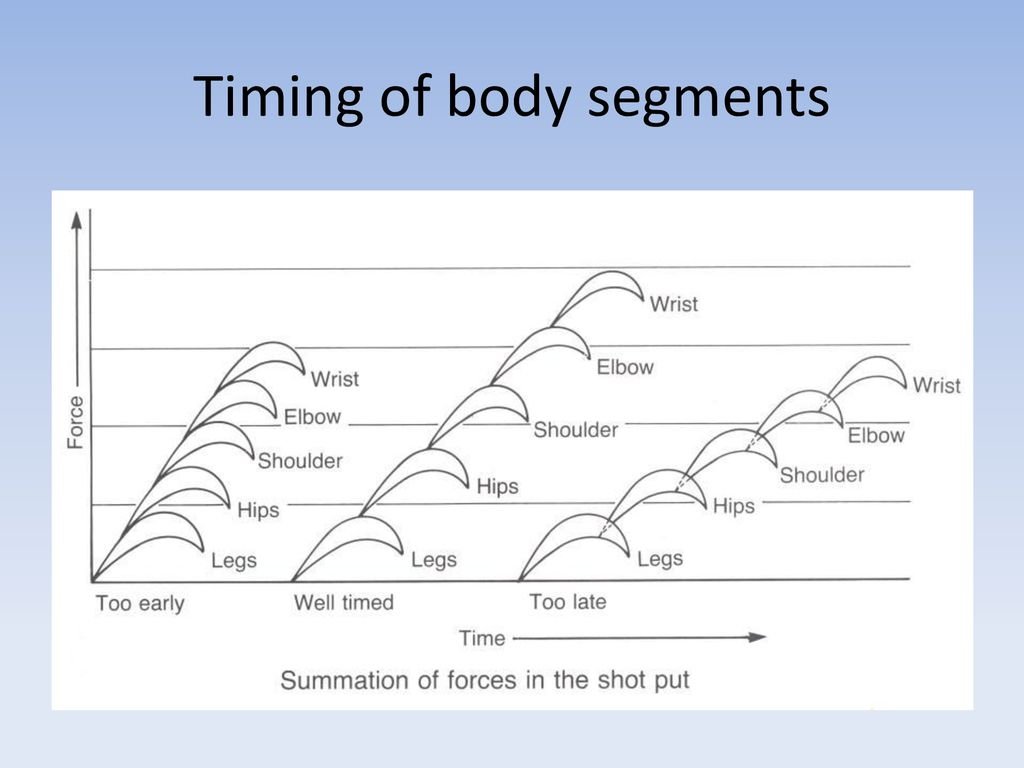Have you ever hit a serve where everything just seemed to come together? You felt coordinated. Powerful. The ball came off your racquet like a rocket.
On the flip side, we’ve all hit serves that felt off-balanced. Off-centered. Lacked pop. And landed everywhere but the service box.
Place technique to the side for a moment and briefly consider these 2 scenarios. In scenario 1, you’re likely striking the ball ‘on time’. Power is coming from the transfer of energy (we’ll get to this in more detail below). And it’s all happening in a properly sequenced manner.
In scenario 2, none of this happens. You accelerate the racquet when you should be driving with your legs. You can barely hold your balance, missing the center of the strings in the process.
These scenarios are closely related to what we call in the biomechanics field, the summation of forces.
Summation of Forces - Timing Side of the Coin
Here’s Kovacs (2011), describing part of this ‘summation of forces’ concept as it relates to the serve:
“The difficulty in the movement results from the summation of forces from the ground up through the kinetic chain and out into the ball.…Effective servers use the kinetic chain via a muscle activation synchrony of the coordinated lower extremity muscles that provide a stable base for the trunk/core to rotate and extend and flex while also helping to produce force. If any of the links in the chain are not synchronized effectively, the outcome of the serve will not be optimal (i.e., velocity, spin, placement, and reliability)
Note that he’s not talking about serve mechanics/technique. In other words, the positions of the limbs/joints at various moments. The speed at which those joints rotate. The forces acting on the involved tissues and so on.
The serve, as described above, is just as much about mechanics as it is about proper timing and synchronization. It’s the coordination of various segments and timing their involvement in the correct order.
When a player does this well - harnesses energy from the ground, up the kinetic chain and into the racquet / ball interaction - as Kovacs implies above, this is what leads to better power, spin, placement and consistency.
Irrespective of how much force a player can generate, if poorly timed, energy leaks present themselves. Not only will this inpart less velocity on the ball, it may lead to suboptimal mechanics (and more stress on certain tissues/structures over others).
Here’s an illustration of the summation of forces during a shot put throw. Notice the total force is higher when each segment is ‘on time’.
Summation of Forces - Force Side of the Coin
What about if you already have a great service motion? Mechanics are solid. Timing is on point.
You guessed it. There’s another side to this story.
Despite the serve needing harmony, it’s still a physical action. A ballistic movement that represents a player’s ability to elicit high amounts of explosive strength.
If you can serve big, it means you have the ability to generate a high amount of vertical propulsive force. And the ability to transfer energy from the ground, up the kinetic chain. The result, angular momentum moving from one segment to the next, gaining energy along the way. Ultimately, this leads to more ball speed. That’s if everything is timed well, remember.
This is the other side of the ‘summation of forces’ coin - the force component.
Summation of forces during the serve.
Each segment will not only harness force from the previous segment, it’ll add to it. This leads to a combination of forces - resulting in total force production (i.e. force summation).
But it all starts from the ground! If we don’t use the ground well during the serve, we won’t optimize the strike. Sure, you might still hit the ball with power, but at what cost?
So how do we develop the ability to generate more force? Ask yourself what type of training will develop more absolute force. The answer - maximum strength training.
Check out the graph below. It shows the correlation between players back squat 1RM and their max serve speed (data from high level players I worked with over the last several years). The correlation coefficient is 0.8, which is a fairly strong positive relationship. In other words, when back squat increases, serve speed tends to increase as well.
But that likely won’t be enough. At a certain point, generating more absolute force could be a hindrance if it’s not allowing a player to generate force quickly (rate of force development - RFD). So what type of training will enable us to develop force at a fast rate? The answer - explosive training (ballistic and plyometric actions).
In a nutshell - we’ll need to squat heavy. And lift weights, jump / throw med balls, explosively. When programmed in a logical, sequential way, these activities can help increase force generating abilities and teach players to sequence forces in the right order. Because remember, we need to develop high amounts of force and time them well…one without the other won’t cut it.
This is how I’ve increased serve speed in basically every player I’ve ever trained. We do some form of squatting, some form of weightlifting or ballistic lifting, some form of jumping/plyometric training and some form of med ball throwing.
The results look something like this:
In this video, you’ll see a player increase serve speed from 106mph to 119mph over a 2 year span. There were no major changes in his mechanics, it was largely due to his physical prep.
Is that it? Well no, you also have to serve a ton too. But that’s a post for another day.
SERVE MAX
BY MATTSPOINT





